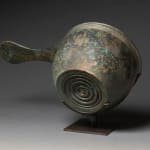Roman Casserole Patera, 1st century A.D., circa AD 55-85
16 x 22 x 44.7 cm
Further images
The highly popular red-gloss wares of the Roman Imperial period (terra sigillata) were typically stamped by their manufacturer. For bronze vessels, however, this practice was much rarer, and seems to have been restricted to a few specific vessel shapes, including the so-called casserole patera, of which the present vessel is an outstanding example. Among the manufacturers of bronze vessels known to us by name, two are distinct both for the quantity of vessels attributed to their hands, and for the exceptional quality of their products: Publius Cipius Polybius and Lucius Ansius Epaphroditus.
The present vessel is signed with a double stamp by the latter: L.ANSI.EPHAPRODITI, and it is certainly one of, if not the, largest known example attributed to his hand. Findings indicate that Lucius and Publius seem to have controlled the largest workshops for the manufacture of bronze vessels at this time, and that they dominated the world market with their goods. Their cognomina indicate that they were probably freedmen, originally of Greek descent, who were working in Capua or the greater Campanian region around AD 55-85.
Ancient writers have extolled the superiority of Campanian bronze and talked of the admiration for these wares among consumers. Pliny the Elder, for example, remarks that ‘the palm of excellence is awarded to that [bronze] of Campania, which is the most esteemed for vessels and utensils’. The present example proves no exception – not only of remarkable size, it represents the epitome of Roman mastery in metalwork, consummately marrying form with function to produce a utilitarian vessel that nevertheless boasts technical expertise and aesthetic appeal. The vessel was cast in a mold and the underside cut on a lathe with elaborately turned grooves, to enable more efficient conduction of heat when the pan was warmed over a fire. The handle has been finely edged with decorative elements on the upper side and finished with a central perforation for suspension, a distinctive feature of this type of casserole. The regularly-spaced lines visible on the interior are measure markers, indicating that the vessel was used for mixing different liquids. The extent of tinning preserved on the interior is remarkable, as is the condition of the vessel in its entirety.
Lucius’ and Publius’ bronze wares have been discovered not only in Campania and elsewhere in Italy, but in the Roman provinces of Moesia, Pannonia, Noricum, and Raetia (corresponding to the regions of the modern-day Balkans, Austria, Hungary, Slovakia, and Switzerland), as well as the Gallic and Germanic Provinces, Britain, and as far afield as the northern Black Sea. The Roman army, stationed throughout the provinces, accounts for the dissemination of these goods throughout the empire, and, indeed, the majority of finds come from military contexts. However, the size and condition of the present example argue against a military use; it is more likely to have been used in a domestic setting, belonging to a family of high standing, perhaps even the Imperial household.
Provenance
Private collection, UK, 1970s;
Collection of E. Enchev, Germany, 1980s-1998;
Private collection, Europe;
Ariadne Galleries, 2017
Literature
The method of manufacture and lathe-turning of Roman bronze casserole paterae is explored by A. Munz, Die Kunst des Metalldrehens bei den Römern (1972), pp. 9-50.
J. Kunow, Die capuanischen Bronzegefäßhersteller Lucius Ansius Epaphroditus und Publius Cipius Polybius, Bonner Jahrbücher 185 (1985), pp. 215-242.S. Tassinari, Il vasellame bronzeo di Pompei (Rome, 1993), pp. 203-204.
R. Petrovszky, Studien zu römischen Bronzegefäßen mit Meisterstempeln, Kölner Studien zur Archäologie der römischen Provinzen, 1, (Buch am Erlbach, 1993).
For Pliny’s comments on the superiority of Campanian bronze, Pliny the Elder, Natural History, 34.20. (34.95); and for Cato’s recommendations on buying bronze from Capua, De Agricultura, 135.1-3.
Join our mailing list
* denotes required fields
We will process the personal data you have supplied to communicate with you in accordance with our Privacy Policy. You can unsubscribe or change your preferences at any time by clicking the link in our emails.






